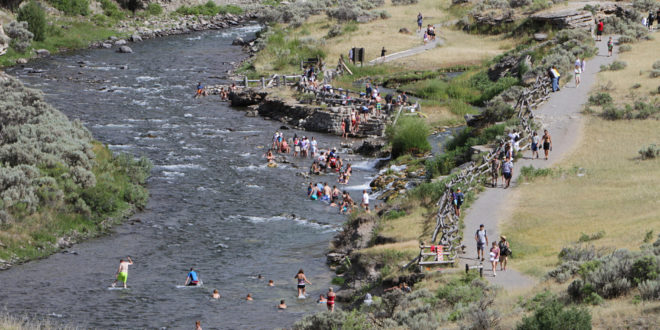If you’re heading to Yellowstone National Park in the next few weeks and hoping for a soak at Boiling River, don’t pack that towel just yet.
Boiling River, the popular swimming spot located between the park’s North Entrance and Mammoth Hot Springs, is closed to swimming due to spring runoff causing high, fast water on the Gardner River.
National Park Service officials don’t just look at the river to decide when it’s too high to safely swim — they use streamflow data from a nearby gauging station. The station is operated by the United States Geological Survey, which posts the data online in real time.
“The threshold for initiating closure is when the Gardner River near Mammoth hits 380 cubic feet per second,” Bethany Gassman, a Park spokeswoman, said May 27.
The river, swollen with snowmelt, rose to 380 CFS on May 7, according to the USGS website.
Boiling River will remain closed until it drops below 200 CFS and stays at that level for three days in a row, Gassman said, adding that typically that level isn’t reached until sometime in July.
National Park Service officials close the swimming area for visitor safety. The parking lot is closed and even walking down to the swimming area is prohibited.
Swimming in hot springs in Yellowstone is illegal and anyone caught doing so is subject to ticketing and fines. Hot springs are not only fragile but dangerous, too — boiling surges can occur at any time in any spring.
But Boiling River is a legal swimming hole because the sweet spot for soaking is found where the hot water coursing downhill from the nearby Mammoth Hot Springs hits the free flowing, cold water Gardner River.
In fact, it’s allowable to swim in the regular cold-water streams where hot water flows into them nearly everywhere where this occurs in Yellowstone. Backcountry locations are well known to park employees and area locals — but few are willing to divulge their favorite spots.
This river flowing downhill from Mammoth is called Boiling River because it’s hot, but not actually boiling. According to USGS data, the river temperature was 116 degrees Fahrenheit May 30.
Up until the early 1980s Boiling River was open year-round and did not close at dusk as it does today. Two young men in separate incidents drowned at Boiling River in 1982, which probably contributed to the Park’s decision to institute nightly and high water closure of the area, according to author and park historian Lee Whittlesey in his book Death in Yellowstone: Accidents and Foolhardiness in the First National Park.
Boiling River has been used by humans for possibly several hundred years. Tepee rings in the area indicate Native American use, Whittlesey has said. And in his book Yellowstone Place Names the listing for Boiling River says a major Yellowstone expedition, the Hayden Survey, found a number of health enthusiasts camped near the swimming area in 1871.
You can watch the Gardner River streamflow online at http://waterdata.usgs.gov/nwis/uv?site_no=06191000. Real-time data on the streamflow as well as the temperature of Boiling River may be found at http://waterdata.usgs.gov/nwis/uv?site_no=06190540.
 Yellowstone Insider Your Complete Guide to America's First National Park
Yellowstone Insider Your Complete Guide to America's First National Park





